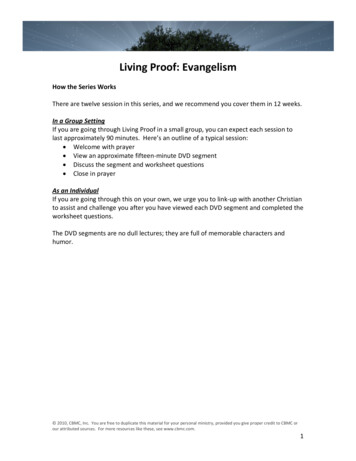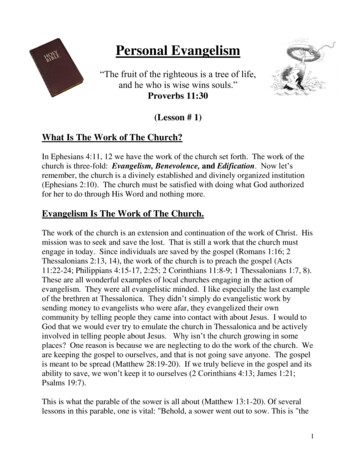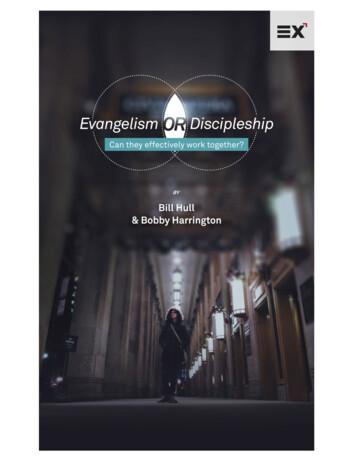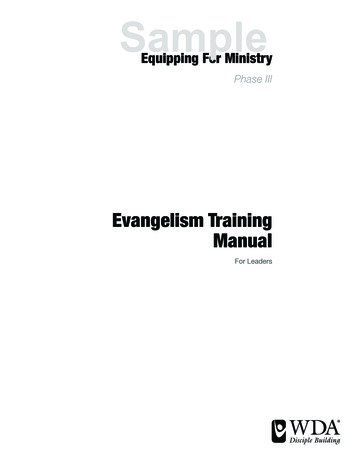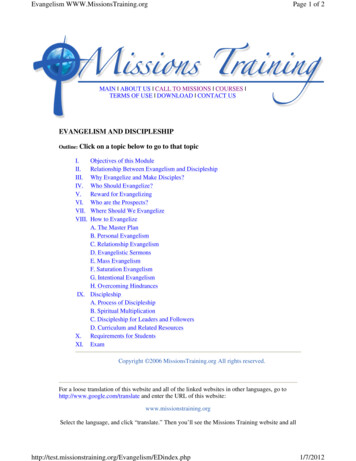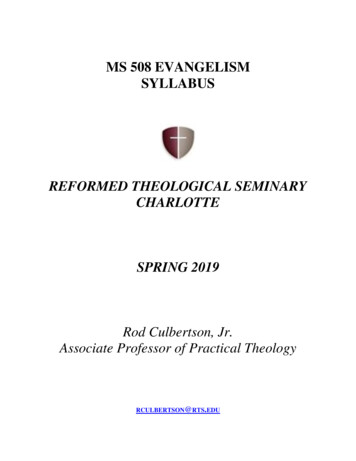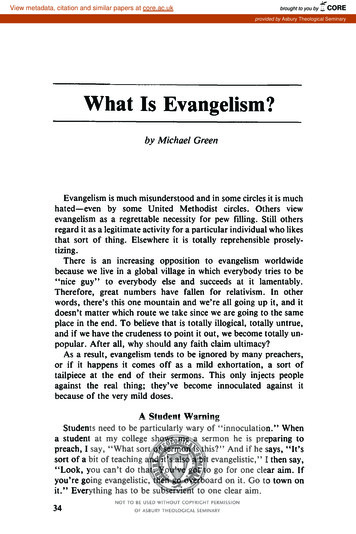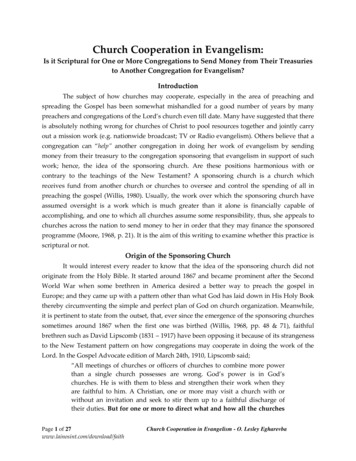
Transcription
Living Proof: EvangelismHow the Series WorksThere are twelve session in this series, and we recommend you cover them in 12 weeks.In a Group SettingIf you are going through Living Proof in a small group, you can expect each session tolast approximately 90 minutes. Here’s an outline of a typical session: Welcome with prayer View an approximate fifteen‐minute DVD segment Discuss the segment and worksheet questions Close in prayerAs an IndividualIf you are going through this on your own, we urge you to link‐up with another Christianto assist and challenge you after you have viewed each DVD segment and completed theworksheet questions.The DVD segments are no dull lectures; they are full of memorable characters andhumor.Answers for facilitators will appear in dotted boxes below each question. 2010, CBMC, Inc. You are free to duplicate this material for your personal ministry, provided you give proper credit to CBMC orour attributed sources. For more resources like these, see www.cbmc.com.1
Meet the CastBill and Jackie Warner – Bill is a 43 year‐old middlemanager. He was raised a nominal Christian, but discoveredwhen he was 30‐something how good the Good News is. Hiswife, Jackie, has been a serious Christian for all of her adultlife.Gerry and Linda Sanders – Gerry is on a fast track to the topof a Fortune 500 company. He had a bad experience withChristians when he was young and wants no part of it.Linda, his wife, seems to be content in this second marriage,but the emptiness of money and career are beginning to getto her. They are Bill & Jackie’s brand new neighbors.Steve Lunsford – Steve is the facilitator of the group. He’s anengineer in his late 40’s and has been committed to lifestyleevangelism for many years. Steve’s hope is to train thiscomplex group to reach their friends with the Gospel.Walt and Anne Ridgeway – Walt works for a multi‐nationalcomputer technology firm. He’s a long‐time Christian butalso a recovering alcoholic. His wife, Anne, spends twomornings each week as a volunteer at the high school.Hayden and Delores Bishop – Hayden is a partner in a lawfirm and an elder in his church. He’s biblically mature, buthas a habit of alienating people by his abrasive outlook onlife. Delores, his wife, has endured a lot from him, but hasmellowed rather than hardened. She’s seen and heard it alland still loves Jesus. 2010, CBMC, Inc. You are free to duplicate this material for your personal ministry, provided you give proper credit to CBMC orour attributed sources. For more resources like these, see www.cbmc.com.2
Marjorie Calloway – Marjorie is a mid‐level manager in aprinting company. Her mother was a great lady of faith, butMarjorie sampled the world for a lot of years before shereturned to the foundation her Mom laid for her as a child.Nick Piracas – Nick is the youngest member of the group andstill recovering from a shocking divorce 2 years ago. Hecame to Christ in college and spent some time with aparachurch missions team in Central America, but he’s notall that grounded in the Bible.Phil Rasouske – Phil was Gerry’s closest friend and drinkingbuddy in Viet Nam, where Gerry nicknamed him “Raz.”When he comes to stay with the Sanders, Bill and Jackie arein for a rude awakening. 2010, CBMC, Inc. You are free to duplicate this material for your personal ministry, provided you give proper credit to CBMC orour attributed sources. For more resources like these, see www.cbmc.com.3
Session 1The Culture GapThe purposes of this session are: To examine the difference between Christian and non‐Christian cultures in NorthAmerica To discover why these differences can become barriers to communicating thegospel To start learning how to get past those barriers1. What are some of the big differences between the values of believers and non‐believers?Values about money, time, priorities, personal conduct, sexual behavior and honesty.Philosophy behind those values:What’s the authority of truth? (Theism, Scientism, Legalism, Secularism, Nihilism)Who’s in charge? (God, Me, Nobody)Why am I here? (Hedonism, Stoicism, self‐fulfillment, no reason)How, then, do we identify with non‐believers?2. What do we have in common that makes it possible for us toreach unbelievers with the good news of Jesus Christ?All human beings are made in God’s image; and, we are all corrupted by sin.“Man is made in God’s image;therefore he has a naturalreceptivity to the truth of theGospel. All evangelism ispredicated on this fact.”-- Jim Petersen, Living ProofGuilt creates openness to the Gospel. Why?3. In Session 1, there were several philosophical statements made byindividuals. Explain why it might be difficult to discuss the Gospel tosomeone who believes these statements:a) Gerry: “I’ll be fine. I’m better than this. There’s only one thingI need and it’s tall and cold and I want it right now.”b) “Life is just going from experience to experience.”c) “The right job equals success, period.” 2010, CBMC, Inc. You are free to duplicate this material for your personal ministry, provided you give proper credit to CBMC orour attributed sources. For more resources like these, see www.cbmc.com.4
d) “My truth is as good as your truth. If you think you can claim any special knowledge,you’re not just kidding yourself, you’re dangerous.”a) False comfort, b) lack of purpose, c) your paid work is the only definition of success, d) truth is relative4. What might make a guy like Gerry receptive to the Gospel despite his worldview and values?His basic strategy for life may be failing. This may make him more open to alternatives.Going DeeperA hundred years ago, believers and unbelievers in Western culture agreed about most ofthe basic issues of life. Almost everybody believed God existed, was a Person, hadcreated the world, and had established certain moral standards reflected in the Bible.But a cultural gap began to crack that consensus, and it’s been widening ever since.First, Darwin and other scientists challenged the idea that God created the world.Believers and unbelievers began to differ over a basic question of life: “How did I gethere?” Scientists and teachers began to apply the scientific method to just abouteverything, including God, and a new idea took hold: we can know only what we canscientifically test and verify. Since God wouldn’t stand still to be weighed and measured,they convinced themselves He was imaginary. 2010, CBMC, Inc. You are free to duplicate this material for your personal ministry, provided you give proper credit to CBMC or ourattributed sources. For more resources like these, see www.cbmc.com.5
Second, scientists declared that people were simply the product of chance and naturalselection. If that’s true, then the purpose for our existence is up for grabs. We aren’there because a loving God created us with a plan, so philosophers opened up a secondquestion: “Why am I here?”As people questioned their origin and purpose, a third explosion widened the culturalgap even further. If the God of the Bible no longer gave us existence and purpose, thenthe Bible’s moral standards should be scrapped too. People asked a third question,“How then should I live?” This issue has burned for decades, until by now most peopleare convinced that the absolute truth (including moral truth) does not exist. Right andwrong have been replaced by doing you own thing. Self has become god. 2010, CBMC, Inc. You are free to duplicate this material for your personal ministry, provided you give proper credit to CBMC or ourattributed sources. For more resources like these, see www.cbmc.com.6
So What?What difference does all this make to us, who base our lives on biblical truth? It makesthis difference: We need to be like the men of Issachar if we want to draw people toChrist.We want people to answer, “How then should I live?” by saying, “I should live byfollowing Jesus Christ.” But there is no way a person can come to that conclusion as longas his answers to the first two questions are that of our culture. Those answers are sodeeply rooted that they are not open for discussion; they’re mostly unconscious. Theyare of the “everybody knows ” variety.Human beings are shaped to the core by their culture. Whether we are taking the gospelto the Japanese or the secularized guy next door, we have to communicate in a languagehe can understand. We have to take his basic assumptions into account – things likerelative truth being the only truth, having no eternal purpose in life, and god being asocial construct.Reaching our neighbors is a cross‐cultural experience. Their assumptions and values areas foreign to our biblical view as those of a tribe that worships ancestors. If we presumethat people are people and talk to our coworkers about repentance, we are in for ashock. That word isn’t even in their vocabulary.Built‐in ReceptorsIs it hopeless, then? That’s often our first sense when we find ourselves surrounded bypeople we do not understand. We may prefer to ignore cultural differences, because wedon’t know how to work with them. But besides being shaped by their culture, all peoplehave two other things in common that make them susceptible to the gospel no matterwhat their culture: They are made in God’s image, and they are fallen.Man is created in God’s image. God has made man unique, significant, and godlike incertain ways. He is able to relate to God as a person to Person. He is conscious ofhimself and is able to make moral choices, and there is something within him that keepshim struggling with the riddle of his own consciousness – until he acknowledges God.That struggle is a built‐in receptor for spiritual truth.Man is fallen. When he fell, three calamities occurred: He came to know good and evil. His life became futile. He died.The knowledge of good and evil shifted man from God‐centeredness to self‐centeredness(Genesis 3:5, 22). Self‐centeredness gave birth to guilt. Guilt alienates. Man wasestranged from himself, from others, and from God. We can count on guilt being within 2010, CBMC, Inc. You are free to duplicate this material for your personal ministry, provided you give proper credit to CBMC or ourattributed sources. For more resources like these, see www.cbmc.com.7
everyone we try to reach with the gospel, and that feeling prods him to seek a resolutionfor it.Futility makes life a pointless struggle (Genesis 3:17‐19, Ecclesiastes 2:22‐23). Weexpend our lives just managing to exist, and then it is back to dust. But the desperatepain of futility drives us to the question, “Why am I doing all this?” and urges us to seekreconciliation with a God who gives meaning to life.At the Fall, man died in every sense of the word. In his relationships and in his spirit, itwas sudden death. His physical death was slower. Man resists death with everything hehas. He is obsessed with fear of it. He just cannot make peace with the idea of mortality.Why? Because God has set immortality in our hearts (Ecclesiastes 3:11). This flight fromdeath and longing for endless life provides another receptor for the gospel.These built‐in receptors provide common ground between believer and unbeliever andgive us hope that even stubborn hearts can be reached. We can face our neighbor’scultural barriers, knowing that they are not the whole story.If we are to be effective ambassadors for the true King, we must understand and careabout the people to whom we are sent. Grieve for them. They have been trained sincebirth to believe falsehood and are surrounded by those who agree with them, but theirbeliefs are a dead end. It will take something drastic for them to turn their back on what“everybody” believes. It will take something drastic, like a love that understands.For Further ReadingJim Petersen, Living Proof, chapter 1‐6.Joe Aldrich, Life‐Style Evangelism, introduction, chapter 3.Joe Aldrich, Gentle Persuasion, introduction, chapter 1.Richard Peace, Small Group Evangelism, chapter 1.Rebecca Pipper, Out of the Saltshaker and into the World, chapter 1.NOTE:¹Os Ginness, The Gravedigger File (London: Hodder and Stoughton, 1983), pages 52‐53. 2010, CBMC, Inc. You are free to duplicate this material for your personal ministry, provided you give proper credit to CBMC or ourattributed sources. For more resources like these, see www.cbmc.com.8
Session 2Our Spiritual ResourcesThe cultural gap between believers and unbelievers is not the only barrier thatchallenges us. Even more formidable is the spiritual gap between unbelievers and God.But we’re not left to our own abilities. In this session, we will: Explore what this spiritual gap is Identify the resources God uses to bridge the chasmAccording to the video, non‐believers are in a spiritual prison.1. From what you have seen in the video and your own experience, what is it like to livein a spiritual prison? For instance, what happens to a person’s Sense of right and wrong Priorities Relationships Perception of reality Self‐esteemSense of right and wrong (no sound basis; based on what seems rightor wrong); Priorities (self serving; out of order); Relationships (self‐serving; failed; painful; let down); Perception of reality? (only whatcan be seen or touched); Self‐esteem (question why am I here?)Non‐believers don’t necessarily see that they are in aspiritual prison and often aren’t interested about the goodnews that Jesus came to rescue them from that prison. Sobecause they are blinded by Satan, they can be reachedonly through spiritual power.“The Spirit of the Lord is on me,because he has anointed me topreach good news to the poor.He has sent me to proclaimfreedom for the prisoners andrecovering of the sight for theblind, to release the oppressed,to proclaim the year of theLord’s favor.”Luke 4:18-19“The god of this age has blindedthe minds of unbelievers, so thatthey cannot see the light of thegospel of the glory of Christ, whois the image of God.”2 Corinthians 4:4 2010, CBMC, Inc. You are free to duplicate this material for your personal ministry, provided you give proper credit to CBMC or ourattributed sources. For more resources like these, see www.cbmc.com.9
2. What spiritual resources has God given us to reach them?God’s Resources for Evangelism The Holy Spirit, who works through inner conviction and circumstances (John 16:8) The Bible, which testifies to the truth (John 1:1, 14; 14:6) The Believer, who prays, lives the truth and witnesses/speaks the truth(1 Corinthians 2:1‐5)3. What do you think it means in practical terms to rely on “a demonstration of theSpirit’s power” in reaching non‐believers (1 Corinthians 2:4)?A changed life; not out to get but to give; joy, peace; wisdom; courage; humility.4. In your experience, how does the Holy Spirit go about convicting someone, as John16:8 describes?“When [the Holy Spirit] comes, he will convict the world of guilt in regard to sin and righteousness andjudgment.” John 16:8You have seen that the believer’s presence andprayers comprise two of God’s resources for reachingthe lost. To start the process, develop a “Ten MostWanted” Card listing those unbelievers whom youwould like to come to Christ. Don’t worry if you can’tthink of ten individuals immediately. God will bringthe rest to mind over the next coming weeks. 2010, CBMC, Inc. You are free to duplicate this material for your personal ministry, provided you give proper credit to CBMC orour attributed sources. For more resources like these, see www.cbmc.com.10
Going DeeperTelling the TruthRepeatedly in the book of Acts, a believer stands up in apublic place, proclaims the truths of the gospel and up to5,000 people accept Christ. The same thing happenstoday in evangelistic crusades. It even happens one‐on‐one in encounters on airplanes and in collegedormitories.Telling the gospel message is essential, but often itdoesn’t work the way we just described. Sometimes when we tell our coworkers aboutJesus, they stare at us blankly and warn the boss that we’re religious fanatics. We getthe treatment Paul got in Athens (Acts 11): ridicule and a cold shoulder.Does that mean we should write our coworkers off as children of darkness? No. Thereis another aspect of reaching the lost. We can call it affirming or showing the gospel. Itis the process of being living proof of the biblical message. We affirm or demonstratethe truth of Christ by our lives.Telling the truth works among the prepared. In Acts 2, the Jews and converts toJudaism have been prepared by the whole of Old Testament history: They know aboutthe true God’s character, His justice, and His promise of a Deliver. In Acts 8, the eunuchhas been involved with Judaism. In Acts 10, Cornelius has believed in the true God forsome time. In Acts 15, the Philippian jailer is prepared by a miraculous encounter withGod’s power. But in Athens, Paul is up against people with no preparation tounderstand the gospel, so his message falls flat.Showing the TruthShowing is how people get prepared for telling. Godcan prepare a heart through special circumstances oreven miracles, as with the Philippian jailer. But mostoften God chooses to use ordinary relationships andexperiences. He uses His people.God raised Israel to be a light to the nations (Exodus 19:6, Deuteronomy 4:5‐8, Joshua4:24, Isaiah 41:12). The idea was that when the surrounding nations saw how just andpleasant a society Israel was, they would be attracted to the God who set up thatsociety. But Israel failed to be light, lapsing into the immoral ways of their neighbors.After God disciplined them for immorality, they failed again to be light because theyturned their liberating laws into harsh, hypocritical legalism. Then the Father sent Jesusto be the true Light, to demonstrate how a person of God would really live. And whenJesus left the earth, He passed His commission onto His team: “You are the light of the 2010, CBMC, Inc. You are free to duplicate this material for your personal ministry, provided you give proper credit to CBMC orour attributed sources. For more resources like these, see www.cbmc.com.11
world . let your light so shine before men that they may see your good deeds andglorify your Father in heaven” (Matthew 5:14,16).That’s affirmation. Being living proof that the Father really is who He says He is, thatJesus really is the Son who frees people from slavery to self, that the Holy Spirit reallycan transform a life. This kind of showing is not a substitute for telling; if we neverexplain the gospel in words, people will never understand it enough to submit to Christ.But showing is an essential preparation for telling. People will buy our words when ouractions back them up.How can we grow in being living proof? There are no shortcuts. We need tocontemplate the great truths of the gospel – how utterly the Father lovers us, howsecure our hope for our future is – until they begin to alter us at the core. But we don’thave to wait until we are great saints to be light for our friends. People will notice eventhe small, slow changes in our ability to love, to serve, to forgive others, to forgiveourselves.For Further ReadingJim Petersen, Living Proof, chapters 13, 14, 20Joe Aldrich, Gentle Persuasion, chapters 2, 4, 5. 2010, CBMC, Inc. You are free to duplicate this material for your personal ministry, provided you give proper credit to CBMC orour attributed sources. For more resources like these, see www.cbmc.com.12
Session 3Mini‐DecisionsIn this session we will: Show why it’s crucial to view evangelism as a process rather than an event oraction Explore the parts of this process Find that coming to Christ is really a series of “mini‐decisions” on the way toconversion1. After watching Session 3 entitled “Mini Steps”, how would you define evangelism?Success in Evangelism: Taking the initiative, in the power of the Holy Spirit, to help a person move onestep closer in the process of coming to Christ.2. Steve used restaurant tableware to illustrate to Bill the process of Gerry making “minidecisions.” Using the chart on the next page, “A Four‐PhaseProcess of Lifestyle Evangelism,” where would you put Gerryon this scale?“The Holy Spirit convicts of sin,3. What are some of the obstacles between Gerry and adecision for Christ? Begin to look into the Word Grasp the elements of the Gospel Recognize his need for a Savior Decide to repent and believerighteousness, and judgment.What a relief to discover that thisresponsibility is assigned to Him,rather than us!” -- Jim Petersen,Living Proof 2010, CBMC, Inc. You are free to duplicate this material for your personal ministry, provided you give proper credit to CBMC orour attributed sources. For more resources like these, see www.cbmc.com.13
2010, CBMC, Inc. You are free to duplicate this material for your personal ministry, provided you give proper credit to CBMC orour attributed sources. For more resources like these, see www.cbmc.com.14
4. Having placed Gerry on the mini‐decision scale, whydo you think he rejected Bill’s invitation to see a musicalat church?Bill was way out in front of Gerry ‐‐ Gerry wasn’t ready for that step.5. Looking at the three phases of coming to Christ, which phase do you see taking themost time and why?Cultivating ‐ it takes time to develop a “safe” relationship which is required to talk to people aboutspiritual matters.Conversion is a process. Every time a person confronts an obstacle, it’s decision time. Few of us make it inone big decision. Instead, it’s a multitude of small choices – mini‐decisions that a person makes towardChrist.6. Choose one person you are praying for their salvation and tell where you think theyare in the process of coming to Christ?Share answers relative to the mini‐decision scale.For Further ReadingJim Petersen, Living Proof, chapter 16, 19Joe Aldrich, Life‐Style Evangelism, chapter 4Joe Aldrich, Gentle Persuasion, chapter 1‐2Richard Peace, Small Group Evangelism, chapter 2 2010, CBMC, Inc. You are free to duplicate this material for your personal ministry, provided you give proper credit to CBMC orour attributed sources. For more resources like these, see www.cbmc.com.15
Session 4Finding Common GroundA blind person in prison can hardly be expected to initiate a friendship that will leadtoward Christ. It’s up to us to make the first move. In this session, we’ll Start learning how to cultivate by taking the initiative and developing commonground with unbelievers Look at reasons why we resist making friends with unbelievers Explore way to overcome those barriers1. What are some of the average ways common ground was established in this video? An experience that touched their common humanity Helping out a neighbor Hobbies and interests, like fishing Having their neighbors in their home Walt drawing Raz out by asking him questions2. What keeps believers apart from unbelievers?“Frequently the unsaved areviewed enemies rather thanvictims of the Enemy.Spirituality is viewed asseparation from the unsaved.3. What keeps unbelievers apart from believers?The new Christian is told he hasFear of judgment, alien ways, feeling as if they have to give up‘nothing in common’ with hissomething.unsaved associates. Quitefrankly, I have a lot in commonwith them: a mortgage, carpayments, kids who misbehave,a lawn to mow, a car to wash, a4. Despite barriers, how is it possible for us to make realless-than-perfect marriage, a fewfriendships with unbelievers?too many pounds around myFriendships are possible if we as children of God are willing to take riskswaist, and an interest in sports,and overcome fears. We can disarm unbeliever’s fears by treating themhobbies, and other activities theywith respect, acceptance, and love. We can put our own fears in theenjoy. It is well to rememberhands of God and seek the support of other believers as we venture intothat Jesus is called ‘a friend ofpotentially unpleasant or tempting territory. We can look for the thingssinners.’”-- Joe Aldrich,Life-Style 2010, CBMC, Inc. You are free to duplicate this material for your personal ministry, provided you give proper credit to CBMC or EvangelismFear of rejection, failure, and contaminationour attributed sources. For more resources like these, see www.cbmc.com.16
we have in common with unbelievers, rather than focusing on the spiritual gap between us.5. What do you think Jesus would have done in Jackie’s situation at her party?Made everyone feel welcomed in His home.He would have been sensitive to His guest’s feelings vs. His own.Jackie resisted a friendship with her neighbors because she feared contamination of her children, herhome, and herself, but others of us are more afraid of rejection or failure.6. How do you feel when you make a friendly overturetoward someone and the door is slammed in your face?It’s time to try another angleUse God as a resourceRemember it is Christ who is being rejected, not me7. How do you think God views people who do their best tobuild a friendship and pray for their friend, but fail to win thetrust needed to take the next step?For a believer who is taking a step in faith, He will build their character toallow them to take the next step as they submit to Him“Most of us fear that who we areinside just isn’t enough. So wecover up our honest questionsand doubts thinking we won’tsound spiritual. But in doingthis, we forfeit our mostimportant asset in evangelism –our real person. Not to acceptour humanness means we loseour point of authentic contactwith the world When we get agood look at Jesus, we will seethat it is not our humanity weneed to fear.”-- Rebecca Pippert, Out of theSaltshaker and into the World.“You are the light of the world.A city on a hill cannot behidden. Neither do people lighta lamp and put it on a its stand,and it give light to everyone inthe house. In the same way, letyour light shine before men, thatthey may see your good deedsand praise your Father inheaven.”Matthew 5:14-16 2010, CBMC, Inc. You are free to duplicate this material for your personal ministry, provided you give proper credit to CBMC orour attributed sources. For more resources like these, see www.cbmc.com.17
Going DeeperFriendship 101If you ask believers why they aren’t building friendshipswith the unbelievers at their workplaces, in theirneighborhoods, or among the parents of their kids’friends, they will often reply, “I’ve tried, but we havenothing in common.” It can seem true. Believers areinterested in spiritual matters or issues at church, whileunbelievers may be indifferent to anything of eternalsignificance. The topics that interest non‐Christians mayseem shallow to those of us with a deeper perspective.However, the fact is that we have a lot of things in common with unbelievers.FamilyWe may have children. If your children are grown, maybe you know of young couplewho would appreciate your taking an interest in their children.WorkIf you are a professional, you might make connections with others in your profession. Ifyou are a secretary, seek out other secretaries with whom you can to go to lunch orafter‐work aerobics. If you are a mechanic, seek mechanics. There’s no law that sayslawyers and mechanics can’t be friends, but if you’re afraid of having nothing incommon, look for people who are guaranteed to share similar interests.If you work with someone, you have something ready‐made in common. It’s sad that sooften workplace socializing stays on the surface level. Christians need to develop the artof drawing people out. You may feel afraid of grilling people with questions aboutthemselves; it seems nosy. But most people enjoy talking about themselves, theirfamilies, where they grew up, where they’ve lived, and so on. Past history is usually asafe subject and can lead to surprising connections: “You used to love fishing? Wow, sodid I! Let’s go fishing sometime.”For Further ReadingJim Petersen, Living Proof, chapters 5, 6, 12, 17Joe Aldrich, Life‐Style Evangelism, chapters 3, 10Joe Aldrich, Gentle Persuasion, chapters 6‐8Richard Peace, Small Group Evangelism, chapter 3Rebecca Pippert, Out of the Saltshaker and into the World, chapters 6‐8 2010, CBMC, Inc. You are free to duplicate this material for your personal ministry, provided you give proper credit to CBMC orour attributed sources. For more resources like these, see www.cbmc.com.18
Session 5Being a Good TestimonyJesus said, “You are the light of the world.” That is great,but how are we that light? Session 5 focuses on: Exploring what being a good testimony is and isn’tIllustrating how to be agood testimony whenasked to participate inany activity we think iswrong, at least for usLearning the first step inarticulating our biblicalworldview, or in otherwords, beginning to“raise the flag” that we base our life decisions andactions on scripture1. Read 1 Corinthians 9:19‐23. How does Paul say hemakes his life a good testimony to unbelievers?He does whatever necessary to conform his lifestyle to whoever he istrying to reach (as long as the situations don’t conflict with hisethics).2. Read 1 Corinthians 9:24‐27. How do these versesapply to Paul’s strategy of being a good testimony?His self‐discipline allows him to socialize in the thick of a paganenvironment without succumbing to immoral temptations.“Though I am free and belong tono man, I make myself a slave toeveryone, to win as many aspossible. To the Jews I becamelike a Jew, to win the Jews. Tothose under the law I becamelike one under the law (though Imyself am not under the law), soas to win those under the law.To those not having the law Ibecame like one not having thelaw (though I am not free fromGod's law but am under Christ'slaw), so as to win those nothaving the law. To the weak Ibecame weak, to win the weak. Ihave become all things to allmen so that by all possiblemeans I might save some. I doall this for the sake of the gospel,that I may share in itsblessings.”1 Corinthians 9:19-23“Do you not know that in a raceall the runners run, but only onegets the prize? Run in such away as to get the
Living Proof: Evangelism How the Series Works There are twelve session in this series, and we recommend you cover them in 12 weeks. In a Group Setting If you are going through Living Proof in a small group, you
